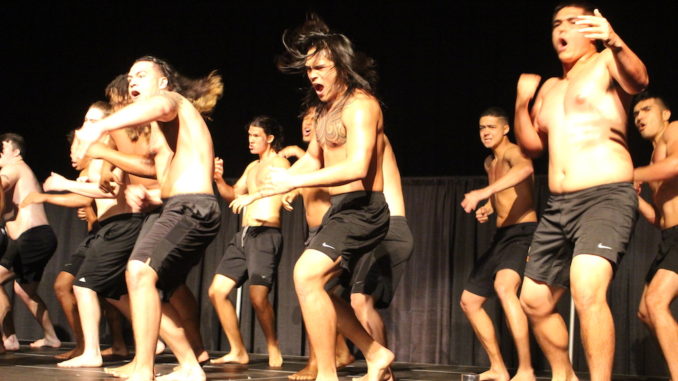
By Joanne Sally Mero
Every year, members of Hawaii Club come together to share the Aloha Spirit with their peers. Luau is one of the largest student-run productions on campus and is anticipated by many students, faculty, staff and community members. One night of enjoyment requires more work than some may think. Almost four months of preparation goes into the four-hour event.
Karli Uwaine ’20 worked behind the scenes creating posters and ensuring that everything ran smoothly.
“There’s just so much more to Luau than the fun and games,” Uwaine said. “It’s a lot of hard work and time that gets put into it.”
All choreographers have a background in dancing hula, which is essentially the visual telling of the song or chant accompanying it. Hawaii Club’s choreographers have years of experience under their belt.
Jessie Ho ’21 choreographed the Tahitian dance for this year’s Luau. She learned hula in a halau, which is a group that comes together to learn the dance and culture.
“I’ve been dancing hula for 12 years,” Ho said. “I’ve been dancing Tahitian very casually for school for two years (of high school).” Ho’s school held yearly performances in which she had the opportunity to lead the teaching of hula dances to her peers.
Mel Hoomanawanui ’20 decided to take up hula as an elective in school.
“I first started dancing in the seventh grade,” Hoomanawanui said. “I chose to take hula because I wanted to learn more about my culture, being from Hawaii and having Hawaiian descent. After the first year I just fell in love with it.”
Hoomanawanui continued learning hula all throughout high school. In his first year at Lewis & Clark, he jumped at the opportunity to teach others. This was his second year choreographing the men’s hula, which balances movement, grace and strength.
Kassie Kometani ’19 learned hula basics at a young age. Like Ho and Hoomanawanui, she quickly fell in love with hula.
“I danced in a halau when I was little with my sister,” Kometani said. “I danced to the point where I loved it and was doing it a lot.”
Kometani has assisted in choreographing many of the Luau numbers in her three years at LC. She has experience in teaching the couples dance, faculty dance, seniors’ dance and is also heavily involved in the organization of the event.
Choreographers have several responsibilities besides teaching the performers. They work with Hawaii Club officers to create a timeline of the semester. Deadlines need to be met for choosing a theme, curating outfits for each performance, placing orders online for additional supplies and ensuring that the costumes fit. Many members in Hawaii Club have other obligations such as sports, overloaded class schedules, jobs and events for other school organizations, so the key to a successful Luau is to start dance practices early on in the spring semester.
“Everybody that does the dances has at least two to three practices a week, and that’s very time-consuming,” Uwaine said.
Students work all semester long to learn authenticity of the culture in order to share it. For the audience, it’s simply one night of enjoyment. It can be easy to get carried away in the fun, but it is also important to understand the deeper roots of Hawaiian culture.
“When you teach hula, you’re not just teaching a dance,” Ho said. “You’re teaching the culture.”
Luau is an event open to all students and doesn’t require having a background in hula. Choreographers ensure the dances are simple enough for newcomers but also honor the song and theme of Luau. One of the main frustrations for coordinators is the occasional disrespect for Hawaiian culture. In past years, audience members can be heard laughing at unfamiliar dance moves.
The haka, which is a traditional Maori war cry, is meant to display the strength of the group. The loud chanting is accompanied by foot stomping or hitting the ground. It is common to amplify intimidation by sticking out one’s tongue and widening the eyes, though some audience members misinterpret this as humorous.
“Everything that’s done in hula or the haka is done with meaning,” Hoomanawanui said. “That’s the most important thing about hula. Everything is done with a purpose.”
When people dance hula, they are telling a story. Choreographers spend hours interpreting songs and lyrics to match certain moves.
It is difficult to attempt to inform the audience and portray authenticity of a culture in one short night. Yet students work all semester long for one performance.
“I really like sharing our culture with everybody,” Hoomanawanui said. “It’s really cool to be able to share and teach other students about our culture in Hawaii.”
Luau is an annual event many students and families in the neighborhood look forward to. Members of Hawaii Club simply want to share the aloha.
“We’ve made better friends with people or have gotten to know people who aren’t even from Hawaii,” Kometani said. “Hawaii Club brings other people together.”
Subscribe to the Mossy Log Newsletter
Stay up to date with the goings-on at Lewis & Clark! Get the top stories or your favorite section delivered to your inbox whenever we release a new issue.

Leave a Reply